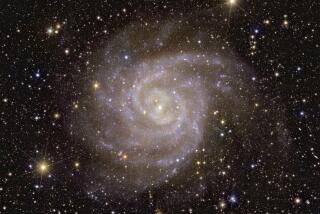SCIENCE ASTRONOMY : 1st Photo by Telescope Destined to Be Largest in World Called Success
- Share via
Scientists from Caltech and the University of California Tuesday released the first photograph taken by what will be the world’s largest telescope when all 36 of its mirror segments are in place and working in concert in 1992.
The Keck Telescope’s “first light” photo of spiral galaxy NGC 1232, 65 million light years from Earth, was taken from the W. M. Keck Observatory atop 13,600-foot Mauna Kea on the island of Hawaii, with just nine of its six-foot-wide hexagonal mirror segments in place.
Yet these alone meant that when the photograph was taken Nov. 24, the 33-foot-wide optical telescope was already as powerful as the Hale Telescope on California’s Mt. Palomar, up to now the world’s largest telescope, according to scientists gathered at a Caltech news conference.
Caltech’s Edward C. Stone Jr., chairman of the group formed in 1985 to build the Keck Observatory and Telescope, said that when the 36 segments are in place, the $94-million telescope will be four times larger than the Hale Telescope in area and be able to look 12 billion light-years into space and backward in time.
“We will be able to see portions of the universe as they were just three billion years after the ‘big bang’ that marked its beginning,” said Stone. Currently, the most powerful telescopes can look as far back as eight billion light-years. A light-year is nearly 6 trillion miles.
The Hale Telescope is one huge mirror, the scientists said. The Keck Telescope, by contrast, is the first to use an automated-mirror design.
With the positions of the segments electronically controlled to an unprecedented accuracy of one-millionth of an inch and adjustments being made by computers at the rate of two every second, the mirrors act in concert as a single optical surface.
The successful first photograph proves that the concept works, said project manager Gerald M. Smith.
Stone said, “First light is the first time the telescope works as a system, as a complete telescope. . . . All of the technology has come together.” But, he added, 19 of the mirror segments, including six spares to be used when original segments are removed for servicing, have not been polished yet, while 14 others have been polished but not installed.
Jerry Nelson, project scientist from UC Berkeley, said the first photograph was a useful test of the optics fabrication, the polishing of the segments and the workings of the control system. He said there are no plans to release further photos in the next year, while the telescope is tuned up as other mirror segments are added.
A second telescope of equal size may be constructed in the future on the Mauna Kea site, the scientists said.
The new telescope will gather 17 times more light than the Hubble Space Telescope, which is orbiting the Earth, and will be able to measure distances and relative speeds of galaxies more precisely, Stone said. Hubble’s advantages are that it is above the distorting influence of the Earth’s atmosphere and can pursue ultra-violet astronomy, which cannot be done from the ground, he said.






